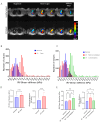This is a preprint.
Magnetic Resonance Elastography and Computational Modeling Identify Heterogeneous Lung Biomechanical Properties during Cystic Fibrosis
- PMID: 38562870
- PMCID: PMC10984019
- DOI: 10.21203/rs.3.rs-4125891/v1
Magnetic Resonance Elastography and Computational Modeling Identify Heterogeneous Lung Biomechanical Properties during Cystic Fibrosis
Abstract
The lung is a dynamic mechanical organ and several pulmonary disorders are characterized by heterogeneous changes in the lung's local mechanical properties (i.e. stiffness). These alterations lead to abnormal lung tissue deformation (i.e. strain) which have been shown to promote disease progression. Although heterogenous mechanical properties may be important biomarkers of disease, there is currently no non-invasive way to measure these properties for clinical diagnostic purposes. In this study, we use a magnetic resonance elastography technique to measure heterogenous distributions of the lung's shear stiffness in healthy adults and in people with Cystic Fibrosis. Additionally, computational finite element models which directly incorporate the measured heterogenous mechanical properties were developed to assess the effects on lung tissue deformation. Results indicate that consolidated lung regions in people with Cystic Fibrosis exhibited increased shear stiffness and reduced spatial heterogeneity compared to surrounding non-consolidated regions. Accounting for heterogenous lung stiffness in healthy adults did not change the globally averaged strain magnitude obtained in computational models. However, computational models that used heterogenous stiffness measurements predicted significantly more variability in local strain and higher spatial strain gradients. Finally, computational models predicted lower strain variability and spatial strain gradients in consolidated lung regions compared to non-consolidated regions. These results indicate that spatial variability in shear stiffness alters local strain and strain gradient magnitudes in people with Cystic Fibrosis. This imaged-based modeling technique therefore represents a clinically viable way to non-invasively assess lung mechanics during both health and disease.
Keywords: Finite Element Modeling; Heterogeneity; Lung Mechanics; Respiratory Disease; Shear Stiffness; Strain Gradients.
Conflict of interest statement
Additional Declarations: No competing interests reported.
Figures






Similar articles
-
Ultrasound Shear Wave Elastography for Liver Disease. A Critical Appraisal of the Many Actors on the Stage.Ultraschall Med. 2016 Feb;37(1):1-5. doi: 10.1055/s-0035-1567037. Epub 2016 Feb 12. Ultraschall Med. 2016. PMID: 26871407
-
Mapping the strain-stiffening behavior of the lung and lung cancer at microscale resolution using the crystal ribcage.Front Netw Physiol. 2024 Jul 10;4:1396593. doi: 10.3389/fnetp.2024.1396593. eCollection 2024. Front Netw Physiol. 2024. PMID: 39050550 Free PMC article.
-
Magnetic Resonance Elastography (MRE) of Bleomycin-Induced Pulmonary Fibrosis in an Animal Model.Invest Radiol. 2023 Apr 1;58(4):299-306. doi: 10.1097/RLI.0000000000000935. Epub 2022 Oct 25. Invest Radiol. 2023. PMID: 36730906 Free PMC article.
-
Developing a Lung Model in the Age of COVID-19: A Digital Image Correlation and Inverse Finite Element Analysis Framework.Front Bioeng Biotechnol. 2021 Oct 26;9:684778. doi: 10.3389/fbioe.2021.684778. eCollection 2021. Front Bioeng Biotechnol. 2021. PMID: 34765590 Free PMC article. Review.
-
Liver fibrosis assessment: MR and US elastography.Abdom Radiol (NY). 2022 Sep;47(9):3037-3050. doi: 10.1007/s00261-021-03269-4. Epub 2021 Oct 23. Abdom Radiol (NY). 2022. PMID: 34687329 Free PMC article. Review.
References
-
- Balleyguier C, Lakhdar AB, Dunant A, Mathieu MC, Delaloge S, Sinkus R (2018) ‘Value of whole breast magnetic resonance elastography added to MRI for lesion characterization’. NMR Biomed, 31 - PubMed
-
- Chagnon-Lessard S, Jean-Ruel H, Godin M, Pelling AE (2017) Cellular orientation is guided by strain gradients. Integr Biol (Camb) 9:607–618 - PubMed
-
- Colasanti RL, Morris MJ, Madgwick RG, Sutton L, Williams EM (2004) Analysis of tidal breathing pro les in cystic fibrosis and COPD. Chest 125:901–908 - PubMed
-
- Diem K, Fauler M, Fois G, Hellmann A, Winokurow N, Schumacher S, Kranz C, Frick M (2020) Mechanical stretch activates piezo1 in caveolae of alveolar type I cells to trigger ATP release and paracrine stimulation of surfactant secretion from alveolar type II cells. Faseb j 34:12785–12804 - PubMed
Publication types
Grants and funding
LinkOut - more resources
Full Text Sources

